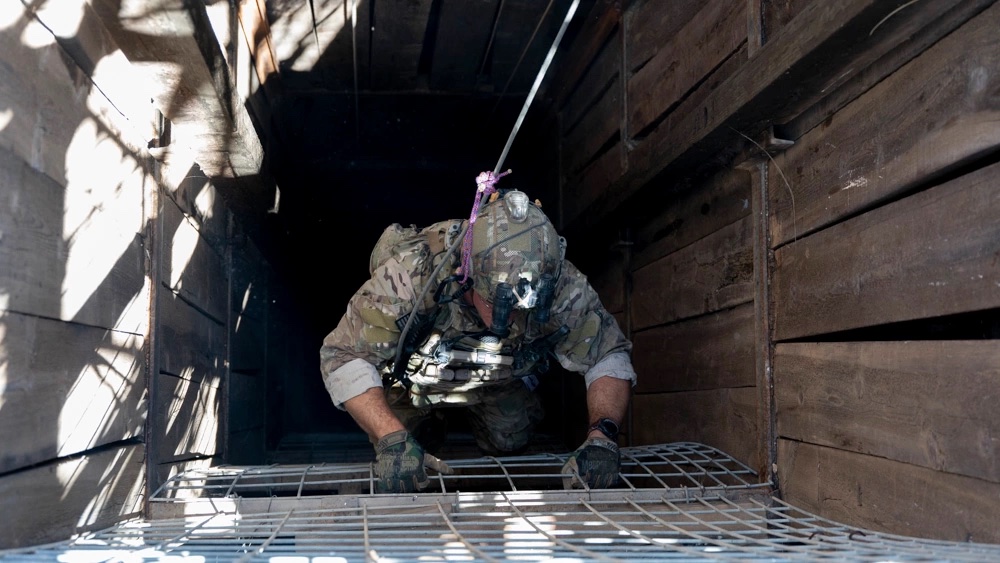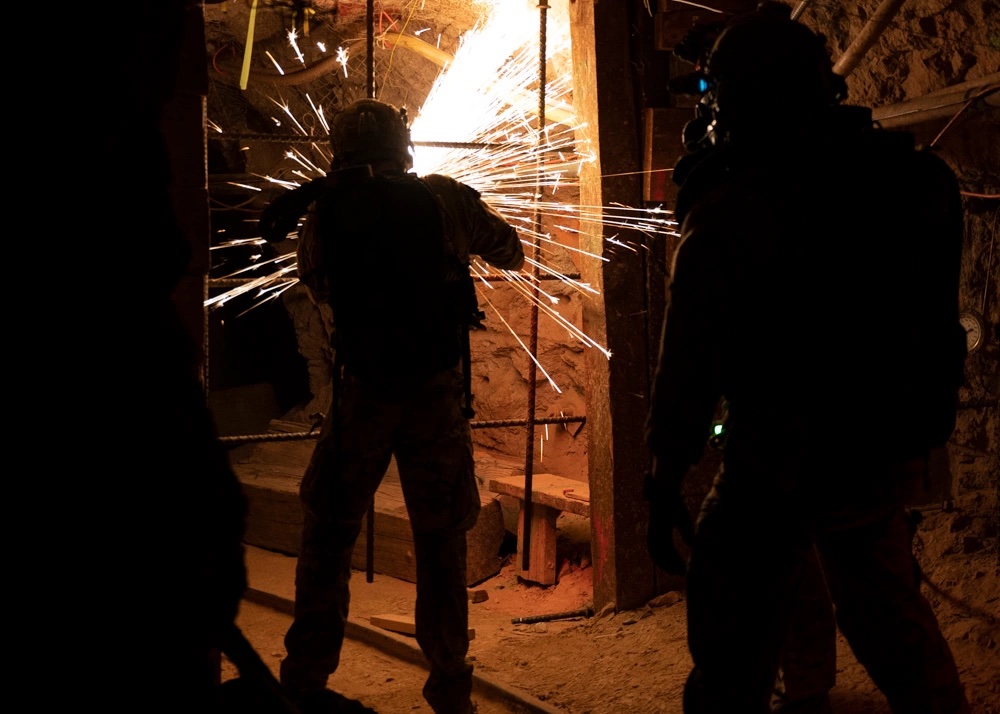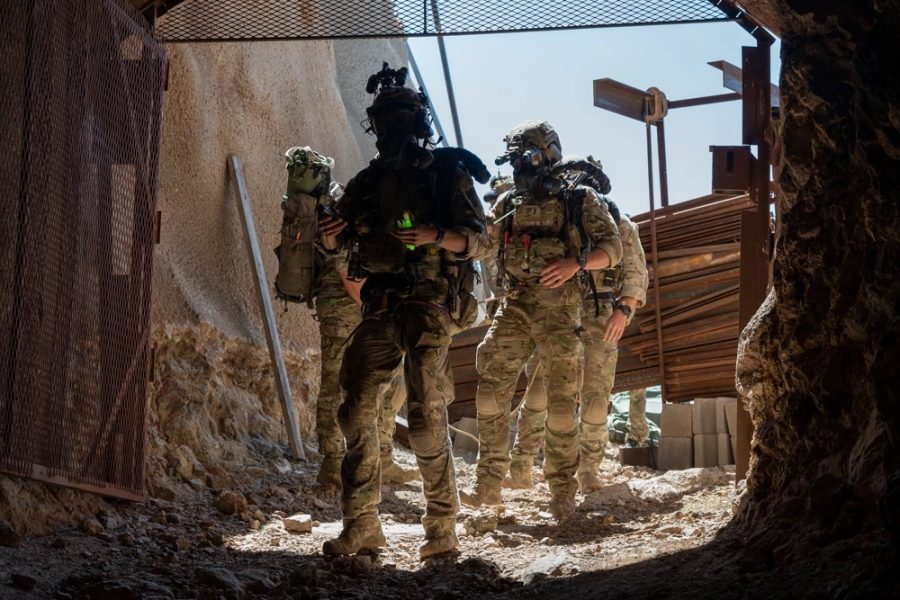Air Force Pararescuemen, also known as ‘PJs,’ are trained to save lives anywhere on Earth, from the middle of a desert to the open water. But while each environment has unique challenges, underground tunnels and caves can be particularly dangerous, leaving rescuers unable to see, hear, and even breathe at times.
In May, PJs got to train in just such dangerous conditions at an exercise hosted by the 414th Combat Training Squadron at the the San Xavier Underground Mining Laboratory, near Tucson, Ariz. From 1880-1952, the mine produced silver, lead, zinc, and copper. Now owned by the University of Arizona, it’s used as a training and research facility for mining and geology students, government agencies, and search and rescue teams.
“The darkness underground and the smoke makes it difficult to see or use lights sometimes,” Master Sgt. Sean Sylvia, a PJ with the Air Force Reserves and the ground operations manager for special warfare with the 414th CTS, told Air & Space Forces Magazine. “It’s sensory deprivation, which is what we’re trying to go for at the training site because that is the biggest lesson the team walks away with: figuring out different ways to handle those types of scenarios.”
The exercise wasn’t just to acclimate PJs to tunnels and caves, though—Tech Sgt. August O’Niell, a section chief of special warfare for the 414th CTS, said there were lessons for confined spaces of all kinds.
“Since we’re rescue specialists, we have to be able to get into and out of all different types of scenarios, and one of those is very small spaces, whether it’s a collapsed structure, or an underground situation, or the inside of cars,” O’Niell said.

In a confined space, rescuers may have to wear firefighter-style breathing masks to filter smoke or toxic gasses; their voices may be muffled or distorted; their radio signals may be blocked by layers of earth and concrete; their night vision goggles may not have enough light to function; and some of the tools they rely on to breach doors and other barriers may set off an explosion due to pent-up gasses.
“It’s a completely different arena,” said Sylvia. “Communication really breaks down in these situations, so you have to figure out with your teammates how you’re going to pass signals and messages back and forth.”
Before the exercise began, the participating PJs went over a system of hand signals, rope pulls, and chem lights (glow sticks), but these can break down under pressure.
“Even with the best-laid plans, things happen when you’re down there,” said O’Niell. “One person, after memorizing all those signals, may mix up a left-hand turn with a right-hand turn and communicate that. It’s something that we need to embed with each team, that they need to work on these things before the entrance to a confined space.”
In the most recent exercise, Airmen responded to a simulated explosion that trapped and injured a handful of patients. The PJs had to breach in, assess the patients, some of whom were screaming in mock pain, treat any immediately life-threatening injuries, and move them out of the mine. To make things more interesting, the mine was completely blacked out and the 414th CTS ran smoke machines “to enforce that sensory deprivation so they can barely see their hand in front of their face,” Sylvia added.
The organizers also closed off the rescuer’s initial entry point, forcing them to rely on their mission prep to find a way out.
“A big thing about going into a space like this is you have to know your environment,” said O’Niell. “We were able to assess if they actually did their map studies by seeing if they were able to find other exits that they had available.”
Just keeping track of one’s gear can be a difficult task.
“They have a lot of equipment that they’re constantly taking on and off to work with,” Sylvia explained. “In those types of situations, if you set something down and you get distracted, you may lose it somewhere in the dark. A lot of it comes down to knowing how your equipment works and not losing it.”

While the May exercise was challenging, there are other scenarios PJs may practice at San Xavier that would challenge them in entirely different ways. One includes a 150-foot vertical shaft that rescuers must descend with ropes. Once they reach the patient at the bottom, they have to figure out how to pull him or her back up without causing additional harm. In the future, the 414th CTS plans on flooding a 100-foot section of one of the mine tunnels, forcing rescuers to dive to reach their patients—a situation reminiscent of the 2018 Thai cave flooding, where rescuers dove through flooded tunnels to reach a trapped youth soccer team.
“There’s only one small entry point at the beginning of it and a very small entry point at the end and then it’s dry after that,” O’Niell said. “They would have to SCUBA dive through this tunnel, come out the other side, treat their patient on that side and then communicate back what is needed to retrieve the patient.”
Ideally, rescuers can move patients out of the dangerous conditions of a mine before administering advanced medical care, but they may not always have that option. The patient may have been pinned beneath a fallen structure or have an injury too serious for movement. Air Force PJs cannot choose which scenario to prepare for, so they are trained to use various extrication tools and medical procedures to keep those patients alive.
“If they’ve been pinned for more than six hours, there are drugs that have to be pushed to keep all of that acidic blood from reentering the body and causing cardiac problems once you’re able to extract them,” O’Niell explained. “The team has to slow down, right? Nobody’s ever running through these types of situations. It takes what’s called a tactical pause to kind of talk through what’s happening and relay it to the rest of your team to get to the next phase.”
Those skills could save lives in a future humanitarian mission or conflict, which some experts predict could include brutal underground fighting.
“Rudimentary tunnel systems as experienced during the Vietnam War are not unique to that conflict; it is an underground pattern that continues today,” wrote four Army majors in a 2013 thesis on subterranean warfare for the Naval Postgraduate School. The thesis, “The Enemy Below,” was also cited by a 2019 series of Army Times articles on the subject.
Going underground can help avoid airborne surveillance or airstrikes. ISIS fighters dug tunnels throughout the Iraqi cities they occupied, and future urban warfare campaigns may include significant subterranean fighting.
Not all Air Force bases have a training mine nearby, and O’Niell said he was grateful Davis-Monthan Air Force Base does. The 414th CTS plans to return this August to put another visiting PJ team to the test.
“Having an area to do these things is key,” he said. “Maintaining proficiency over currency is something that is highly sought after and rarely happens with certain skill sets. It’s important that our guys are able to go after some things like this.”
